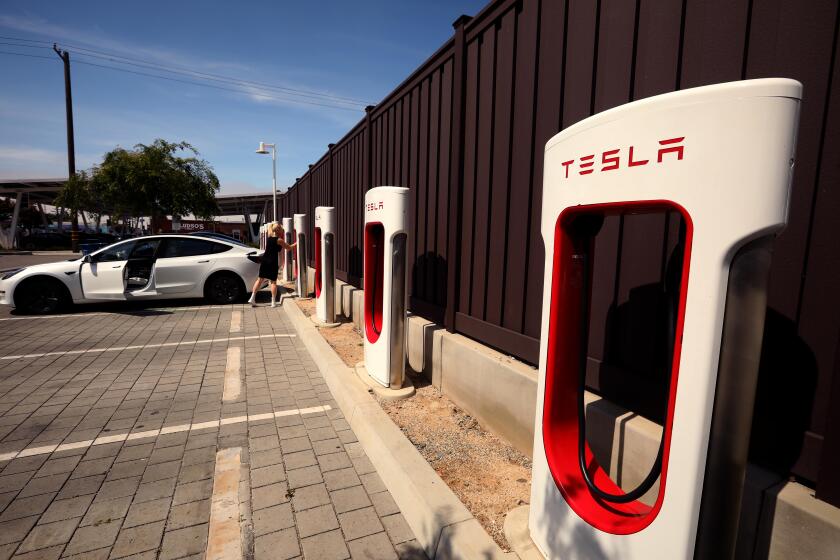Fuel-Cell Vehicles Are Advancing Toward First Real-World Tests
After almost a decade of hailing fuel-cell technology as the ultimate replacement for the internal combustion engine, auto makers are slowly starting to put some fuel-cell-powered vehicles on the streets.
Toyota Motor Corp. said Monday that it would produce 20 fuel-cell powered versions of its Highlander sport utility this year to lease to researchers, businesses and agencies that have an adequate supply of the hydrogen needed to fuel the vehicles.
Toyota wants to use the limited fleet to gather real-world driving and performance data before it increases production of fuel-cell Highlanders.
For the same reason, Honda Motor Corp. plans to make a small but undetermined number of fuel-cell vehicles available for testing next year, said Ben Knight, vice president for automotive engineering. “It’s a great way to get feedback,” he said.
DaimlerChrysler will place 30 fuel-cell buses in 10 European cities, said Dirk Walliser, a co-director of the German-American auto maker’s fuel-cell project. “We find it is the furthest we can go into commercialization right now,” he said.
And Ford Motor Co. is sending five fuel-cell vehicles to California this year for testing. Ford hasn’t “achieved a commercially viable design,” but will have a limited number of vehicles for fleets available in 2004, said Bruce Kopf, director of Think Technologies at Ford.
The auto industry is sticking to estimates that mass-produced fuel-cell vehicles will not be possible until 2010 at the earliest, mainly due to cost, infrastructure and safety issues.
“Certainly there are technical challenges, but there’s been so much public and private investment the public ought to expect these vehicles within the decade,” said Jason Mark, a transportation analyst for the Union of Concerned Scientists.
Fuel cells use a chemical reaction between oxygen and hydrogen to produce electric power. When pure hydrogen is used, the only tailpipe emission is harmless water vapor.
When hydrogen is extracted from gasoline or other fuel, harmful emissions are reduced but not eliminated. However, to use fuels other than pure hydrogen, vehicles must be equipped with a heavy and expensive reformer that extracts hydrogen from those fuels.
Hydrogen is a flammable gas that poses safety concerns, especially in a crash. Several suppliers are working on strong but light on-board storage systems. The lack of a network of hydrogen filling stations presents another obstacle.
DaimlerChrysler expects to make more fuel-cell vehicles available in the United States in 2004, mainly for fleet operations, Walliser said. General Motors Corp. and Nissan Motor Co. said they planned to make the vehicles available for fleet sales in 2005.
Toyota already has made two hydrogen fuel-cell vehicles based on its Highlander SUV available to the California Fuel Cell Partnership for evaluation.
In January, the federal government announced a partnership with U.S. auto makers called Freedom CAR, with the goal of accelerating the development of fuel-cell vehicles and a hydrogen fueling infrastructure.
Though the cost of fuel-cell vehicles has fallen since they were first built in the late 1990s, they still are too expensive to sell at a profit.
With gasoline relatively cheap in the U.S., people are not motivated to pay more for vehicles that run on something else. “Who is going to invest in mass production without a market?” Ford’s Kopf asked.
But Daniel Becker, the Sierra Club’s director of global warming and energy programs, said U.S. auto makers were dragging their feet in bringing fuel-cell vehicles to market.
History has shown the industry capable of doing many things it first said it could not do, Becker said.
“This is the industry that said, ‘We can’t make vehicles with seat belts, we can’t make vehicles with air bags, we can’t make vehicles that get 35 miles a gallon.’ ”
FutureTruck Winners
A team from UC Davis captured third place overall and a spate of specialty awards in the 2002 FutureTruck competition that ended late last month. The contest is the second in a four-year program designed to foster methods of making trucks, which account for slightly more than half of all new passenger vehicles sold these days, more fuel-efficient and environmentally friendly.
The UC Davis team took first place in the competition last year, when the goal was to modify a Chevrolet Suburban for improved fuel economy and emissions while maintaining performance at or near stock levels.
This year’s challenge was to do the same with a Ford Explorer. The UC Davis entry was a “plug-in” hybrid electric version in which an on-board battery and electric motors provided power during low-speed city driving and on trips of up to 50 miles. A small, fuel-efficient gasoline engine took over for extended highway driving. The batteries were recharged at night using off-peak electricity, but in the absence of a charging station the vehicle also could be driven using only the gasoline engine.
First place overall was captured by the University of Wisconsin at Madison, and Michigan Technological University placed second.
The Wisconsin team used a bio-diesel hybrid electric power system and specially engineered weight-saving components such as an aluminum-and-steel frame and a titanium exhaust system to improve the stock Explorer’s gas mileage by 45% while cutting greenhouse gas emissions by 50%.
In addition to its third-place overall finish, the UC Davis team won for best use of renewable fuels and for best use of advanced technologies. The team’s entry also was judged the most consumer-acceptable of the 15 vehicles in the competition.



